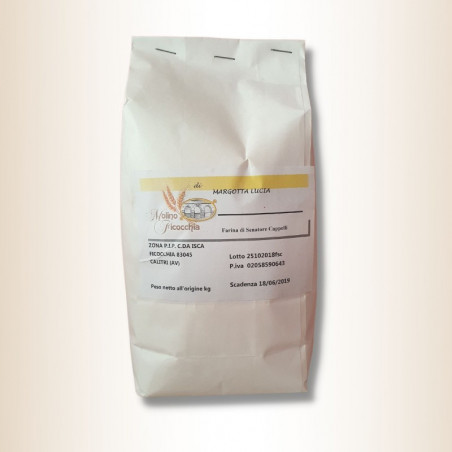- Out-of-Stock




The Buckwheat Flour produced from wheat grown strictly in Italy, stone ground according to Italian traction.
Buckwheat flour even if it looks darker and rougher than wheat flour.
Buckwheat is rich in phosphorus, calcium, iron, magnesium, copper and the percentage of potassium is higher than that of other cereals.
It also contains water, ash, dietary fiber, proteins, fats and carbohydrates and some minerals.
continue reading

Buckwheat flour is a particularly sought-after product in the rediscovery of "ancient flavors", typical product of the Italian culinary art, the color is slightly greyish, while the touch is slightly rough.
Buckwheat is dietary, has very few calories per 100 grams of product and a strong satiating power, it also has evident slimming properties and is particularly suitable for those who want to lose weight.
In addition, it is also recommended for vegans and vegetarians who need to introduce much more non-animal protein into their diet to avoid possible deficiencies.
Buckwheat is playing an important role, which is a product that is often highly sought after by those who practice alternative diets such as macrobiotic cuisine and also by celiacs, given its characteristics.
Buckwheat, even if from the name it would seem wheat, it is not, it is one of the lesser known cereals.
Buckwheat, which is everything but wheat, belongs to what are defined as pseudocereals, plants that are botanically completely different from cereals but which have similar processing products in common.
Along with him are amaranth and quinoa.
It arrives in Italy thanks to maritime trade through the Black Sea, and only after the Middle Ages does it acquire a distribution and cultivation worthy of note even at a European level.
Buckwheat is still widely used in traditional cuisine; in fact, it is part of many world recipes and the Italian culinary tradition.
For example, buckwheat is used in mountain cuisine as a basic ingredient for the production of "polenta taragna", "pizzoccheri valtellinesi" and "sciatt", typical sweets from Valtellina.
In reality, buckwheat was considered a low quality product, the grain of the poor as it was cheaper to produce but with poor aptitude, especially for bread making.
For this reason, its flour was often added to wheat flour to counterfeit food.
The advent of industrialization and the possibility of growing wheat at much lower costs than in the past, therefore, has practically eradicated the Saracen.
Buckwheat flour is practically impossible to rise, or at least it rises very little if taken alone.
This is because it has little ability to form, by binding to water, the starch "network" inside which the air bubbles remain trapped, and this means that, for example a bread, can rise in a limited way (such as if a balloon bursts) and the air bubbles will be very small, like those of sandwich bread to understand.
Since even putting the yeasts they cannot eat, and therefore perform their function, the leavening of buckwheat flour can only be a chemical leavening, never microbiological.
But not only that: its starch is scarcely available for yeasts, the small mushrooms that feed on it at a suitable temperature and from it produce the gas which, in fact, causes it to rise.
In short, it rises by chemical reaction only with instant yeast.
As flour is ultimately difficult to process, its production and use are limited.
We can use this flour only for some particular products.
Alongside traditional products such as pizzoccheri and manfrigoli, we find it used in some biscuits, baked goods that lend themselves better than others to the use of buckwheat flour.
Of course it is possible to mix buckwheat flour with other flours.